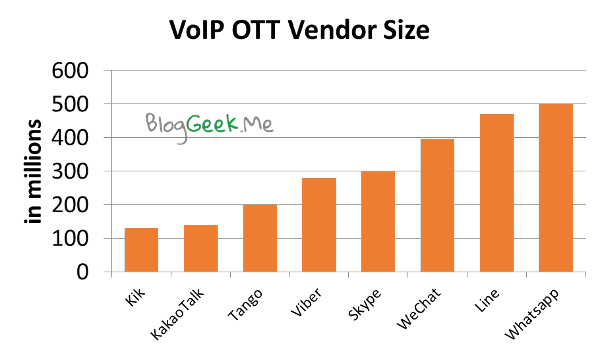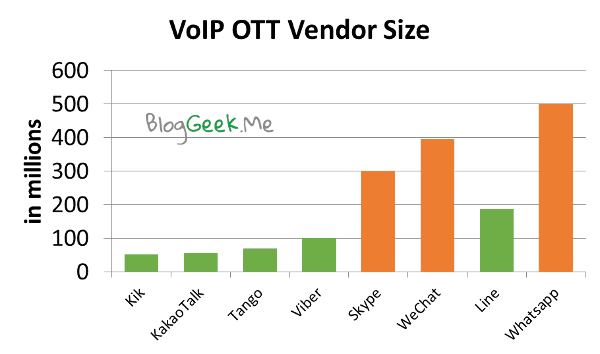Who cares how many users you have if they aren’t active?
There’s a trend taking place lately – it is a shift from talking about registered users and downloads to speaking about monthly active. It is a shift from size to engagement. From bragging rights to essence.
The first time I bumped into this is when I started following the VoIP OTT space a lot closer. I took a look at the players and the numbers they were reporting.
Here’s a quick exercise for you – who’s the bigger player?

The thing is, we’re not comparing the same numbers – some of these players count registered users while others count Monthly Active Users. For those that report only registered users, I’ve estimated a 1:2.5 ratio and marked the estimations with green bars. I got the following graph:

Who’s the bigger player now?
At Google I/O, Google started talking about MAU. Monthly Active Users.
They have switched from the number of downloads they have for things and the number of activations for Android and instead talked about monthly active. Why? Because these numbers are now really impressive.
Android is at a billion active devices on the Google Play Store and the mobile version of Chrome has 300 monthly active users on mobile.
–
We are shifting from bragging rights of scaling our database to large number of users to bragging rights of scaling our actual service and engagement (=communication infrastructure).
What are you counting in your service?

Good post – I completely agree.
Standby for some upcoming forecasts on WebRTC DAUs/MAUs….
Dean
Monthly active users is a good proxy for census. Tencent’s been doing something like that quarterly for years, the number of people who signed in to QQ in the last n weeks of the quarter (I think six, if I recall).
So this tells you the number of nodes that might light up.
You also want to know how much those nodes are available for conversation. For instance, early Skype didn’t have any way to ring you if you had your client turned off. So they focused hard on building dialtone: using push messaging on mobile to get you to answer a call, preinstalling Skype on desktops with the default to start at startup, etc.
The capacity of your OTT network is the census * dialtone; minutes of availability. You aspire to having every user connected 24 hours out of every 24 hours . If only for 6 hours a day, then your network has 25% dialtone. Each network has a different dialtone tipping point where users feel synchronous communication works well, at least for their part of the network and for strangers they are likely to reach..
It’s not enough that each user is connected to the network. They really need to be connected to their own social set, the people they want to talk with, the communities to which they belong. You see “add your contacts?” as part of customer onboarding for a reason. So you could compare networks for how many contacts on those networks do people know. For example, in Skype’s early days, they were doing well if users had a dozen contacts in their directory.
Now that people often have hundreds of contacts dragged in from mobile directories and facebook friends, perhaps it’s time to start measuring relationship strength; how well does this network help you repeatedly engage your friends, coworkers, customers, teammates over time?
But the whole point of a communications network is talk. How much are people talking? In landline days you might have counted total minutes served per period or minutes per subscriber. Today’s users substitute and switch modes, freely jumping from SMS to in-app texting, to voice messages, to live calls and back. We need measures of engagement, of how much conversation is happening across the network per person.
Phil,
While all of this is valid, it doesn’t take into account the fact that communications isn’t always about “talk”.
When I see Google talking MAU on Android and mobile Chrome – this has nothing to do about “talk”, but both are about communications and engagement. That’s rather new. Until now, for iOS and Android you got statis for total # of messages, registrations, downloads, etc. – these are nice, but may not correlate directly to engagement.
And while Tencent/QQ/WeChat and Whatsapp both tracked and published MAU, LINE provides registrations. So not all are talking in the same language.